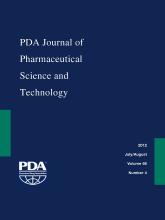Abstract
The ASTM 838-05 standard describes a bacteria challenge test procedure based on Brevundimonas diminuta (ATCC 19146) to verify a 0.2 μm rated sterilizing-grade filter. For process validation procedures a correct identification of the challenge organism is essential. The test strain ATCC 700892 repeatedly used for microbial challenge tests was incorrectly named Hydrogenophaga pseudoflava but is phylogenetically linked to the genus Curvibacter, as shown in Part I of this series. Based on these studies the misconception was consolidated that Hydrogenophaga pseudoflava, a widely isolated microorganism also found in biopharmaceutical production settings, is able to penetrate 0.2 μm rated filters. Here we show that the bacteria challenge test results of the strains Curvibacter sp. ATCC 700892 and Hydrogenophaga pseudoflava ATCC 33668 are different. In previous challenge tests analytical filter membranes were used; these do not represent the process scenarios within the sterilizing filtration in industrial processes. To represent process systems, the study data presented were determined with 10" filter cartridge elements. The strain Hydrogenophaga pseudoflava ATCC 33668 is completely retained by 0.2 μm and 0.1 μm rated filters. Depending on the different 0.2 μm filter material there are different retention rates of the strain Curvibacter sp. ATCC 700892; only the 0.1 μm rated filters showed consistent complete retention. However, up to date the genus Curvibacter seems to be of low relevance within biopharmaceutical production settings.
LAY ABSTRACT: Bacteria challenge tests are used to determine the retention performance of sterilizing-grade filters. The model organism used for bacteria challenge tests and the verification of a 0.2 μm rated sterilizing-grade filter is Brevundimonas diminuta. In previous studies another proposed, model organism used for challenge tests was incorrectly labelled as Hydrogenophaga pseudoflava. Given the predefined retention characteristics, this mislabelled organism was recommended to be included in bacteria challenge studies. However, the herein presented testing demonstrated that the organism is actually phylogenetically affiliated to the genus Curvibacter and not to the strain Hydrogenophaga pseudoflava ATCC 33668. In this report, we demonstrate that the retention of the strain Hydrogenophaga pseudoflava ATCC 33668 with 0.1 μm and 0.2 μm rated filters is comparable to the retention of Brevundimonas diminuta ATCC 19146.
- Microbial challenge test
- Bacteria challenge test
- Analytical membrane filter
- Process filter
- 0.2 μm rated filter
- 0.1 μm rated filter
- Hydrogenophaga pseudoflava, Curvibacter
- © PDA, Inc. 2012
PDA members receive access to all articles published in the current year and previous volume year. Institutional subscribers received access to all content. Log in below to receive access to this article if you are either of these.
If you are neither or you are a PDA member trying to access an article outside of your membership license, then you must purchase access to this article (below). If you do not have a username or password for JPST, you will be required to create an account prior to purchasing.
Full issue PDFs are for PDA members only.
Note to pda.org users
The PDA and PDA bookstore websites (www.pda.org and www.pda.org/bookstore) are separate websites from the PDA JPST website. When you first join PDA, your initial UserID and Password are sent to HighWirePress to create your PDA JPST account. Subsequent UserrID and Password changes required at the PDA websites will not pass on to PDA JPST and vice versa. If you forget your PDA JPST UserID and/or Password, you can request help to retrieve UserID and reset Password below.






